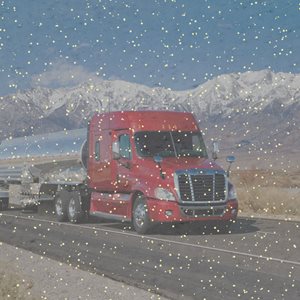 The past few weeks, most of the country has been hit with poor driving conditions. Artic storms have even made their way into some of the southern states that normally do not have to worry about poor winter driving conditions, like the rare snow and ice storm in the Dallas-Fort Worth, TX area. Here are some winter safety tips to help reduce your risk of accidents and help keep you safe on the road.
The past few weeks, most of the country has been hit with poor driving conditions. Artic storms have even made their way into some of the southern states that normally do not have to worry about poor winter driving conditions, like the rare snow and ice storm in the Dallas-Fort Worth, TX area. Here are some winter safety tips to help reduce your risk of accidents and help keep you safe on the road.
Winter driving tips:
- Be prepared. Plan each trip to avoid winter storms if possible by checking forecasts and potential construction areas along your route. Chart fuel, meal stop locations, and allow extra time for traffic delays. There are several weather alert tools available. Try the Weather Channel’s tool. It sends you severe weather alerts in your area via email or text message. Sign up here.
- Perform a thorough pre-trip inspection. Do a visual, hands-on inspection and check important items, including tires, wiper blades, fluids, and lights. Listen carefully for air leaks. Small leaks can become big leaks in extreme cold. Check your vehicle at every stop. This video from Michelin Tires is a great resource on how to thoroughly check your tires.
- Purchasing fuel. In extreme cold temperatures fuel can thicken or gel. Whether, you want to keep a half tank of fuel or not, remember a full tank is less apt to have problems. Purchase fuel as far North as you can to limit or eliminate the amount of additives you have to use.
- Check your cargo. Goods shifting in the trailer and icy roads are not a good combination. If possible, monitor the shipper’s loading procedures to ensure weight has been evenly distributed within the trailer.
- Slow down. Slow down when there is bad weather. Everything takes longer on snow-covered roads. Accelerating, stopping, and turning happen slower than it would on dry pavement. Give yourself time to maneuver. If you choose to drive slower than other traffic, make sure to avoid the “fast lane” on highways.
- Give yourself extra space. The normal dry pavement following distance should be increased. Double or triple your following distance and never tailgate. This increased margin of safety will provide the longer distance needed if you have to stop. Keep at least a ten second following distance when driving on snow and ice covered roads.
- Turn OFF cruise control. Never use cruise control on icy roads.
- Beware of black ice. Black ice can fool drivers into thinking its liquid. Black ice is one of the most slippery and dangerous road conditions. Black ice is likely to form first under bridges and overpasses, in shady spots, and at intersections. Remember that bridges and overpasses freeze before roadways. A bridge will follow the air temperature very closely. If the air temperature falls below freezing, a bridge's surface will fall below freezing very quickly. Rain or snow, therefore, will freeze and stick to the bridge.
- Braking and accelerating. As a driver, you have to know whether or not your truck has anti-lock brakes (ABS). Air brakes without ABS must be applied differently than those with ABS. If you have ABS and the brakes happen to lock, release them to avoid sliding. This will help to regain steering. Always brake gently to avoid skidding.
- Avoid Skids. Most skids are the result from driving too fast for road conditions. If your speed is correct for conditions, you don’t have to over-accelerate, over-brake, or over-steer. An uncontrolled skid could lead to a jackknife. Recovering from a jackknife involves these steps:
- Speed control
- Corrective steering
- Counter-steering
- Braking to a stop
Competent drivers do not let winter driving conditions get in the way of controlling their truck and staying safe. Follow these tips and try to stay calm, cautious and respectful of other drivers on the road this winter.